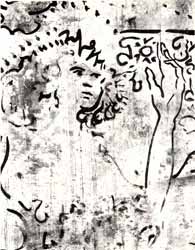|
[see Ontological Antitheses, Symbolism]
Memory and imagination may be regarded as perception in the pure mode of causal efficacy.
 “The true artist does not copy nature.
Here…[Plotinus] agrees with Philostratus, who in an epoch-making passage says that great works of art are produced not by imitation (the Aristotelian mimesis), but by imagination (phantasia), ‘a wiser
creator than imitation; for imitation copies what it has seen, imagination what it has not seen.’” (W.R. Inge, The Philosophy of Plotinus, II, p. 216, quoted in William M. Ivins, Jr., Art and Geometry, p. 607.) “The true artist does not copy nature.
Here…[Plotinus] agrees with Philostratus, who in an epoch-making passage says that great works of art are produced not by imitation (the Aristotelian mimesis), but by imagination (phantasia), ‘a wiser
creator than imitation; for imitation copies what it has seen, imagination what it has not seen.’” (W.R. Inge, The Philosophy of Plotinus, II, p. 216, quoted in William M. Ivins, Jr., Art and Geometry, p. 607.)- “…it is clear that we must conceive that which is generated through sense-perception in the sentient soul…--viz. that affection the state whereof we call
memory—to be some such thing as a picture. The process of movement involved in the act of perception stamps in, as it were, a sort of impression of the percept…” (Aristotle, “De Memoria et Reminiscentia,” The Basic Works of Aristotle, p. 609.)
- “Impressions may be divided into two kinds, those of Sensation, and those of Reflexion. …the imagination is not restrain’d to the same order and form with the
original impressions; while the memory is in a manner ty’d down in that respect, without any power of variation.” (Hume, A Treatise of Human Nature, pp. 7, 9.)
- “…we are not dealing with an isolated act, but with a progressive process of determination. At the first level, the fixation of the content through the linguistic
sign, the mythical or artistic image, seems to do no more than hold it fast in the memory, it does not go beyond simple reproduction. At this level the sign seems to
add nothing to the content to which it refers, but merely to preserve and repeat it. Even in the history of the psychological development of art it has been thought
possible to identify a phase of mere “recollective art,” in which all artistic endeavor was directed solely towards stressing certain features of what was perceived by the
senses and presenting it to the memory in a man-made image. But the more clearly the particular cultural forms disclose their specific energy, the more evident it
becomes that all apparent “reproduction” presupposes an original and autonomous act of consciousness. The reproducibility of the content is itself bound up with the
production of a sign for it, and in producing this sign the consciousness operates freely and independently. The concept of “memory” thus takes on a richer and
deeper meaning. In order to remember a content, consciousness must previously have possessed itself of that content in a way differing from mere sensation or
perception. The mere repetition of the given at another time does not suffice; in this repetition a new kind of conception and formation must be manifested. For
every “reproduction” of a content embodies a new level of “reflection.” By the mere fact that it no longer takes this content as something simply present, but
confronts it in imagination as something past and yet not vanished, consciousness, by its changed relation to the content, gives both to itself and the content a changed ideal meaning. And this occurs more and more precisely and abundantly
as the world of representations stemming from the “I” becomes differentiated. The “I” now exercises an original formative activity all the while developing a deeper understanding.” (Cassirer, The Philosophy of Symbolic Forms, pp. 89-90).
- “The photographer fundamentally converts the movement of life into the stillness of form. The person viewing the photograph converts the stillness of form back
into the movement of life by means of his imagination.” (Willi Baumeister, The Unknown in Art, Cologne: 1960, p. 141.)
|
|

 “The true artist does not copy nature.
Here…[Plotinus] agrees with Philostratus, who in an epoch-making passage says that great works of art are produced not by imitation (the Aristotelian mimesis), but by imagination (phantasia), ‘a wiser
creator than imitation; for imitation copies what it has seen, imagination what it has not seen.’” (W.R. Inge, The Philosophy of Plotinus, II, p. 216, quoted in
“The true artist does not copy nature.
Here…[Plotinus] agrees with Philostratus, who in an epoch-making passage says that great works of art are produced not by imitation (the Aristotelian mimesis), but by imagination (phantasia), ‘a wiser
creator than imitation; for imitation copies what it has seen, imagination what it has not seen.’” (W.R. Inge, The Philosophy of Plotinus, II, p. 216, quoted in